check engine MITSUBISHI COLT 2008 (in English) User Guide
[x] Cancel search | Manufacturer: MITSUBISHI, Model Year: 2008, Model line: COLT, Model: MITSUBISHI COLT 2008Pages: 450, PDF Size: 14.57 MB
Page 201 of 450
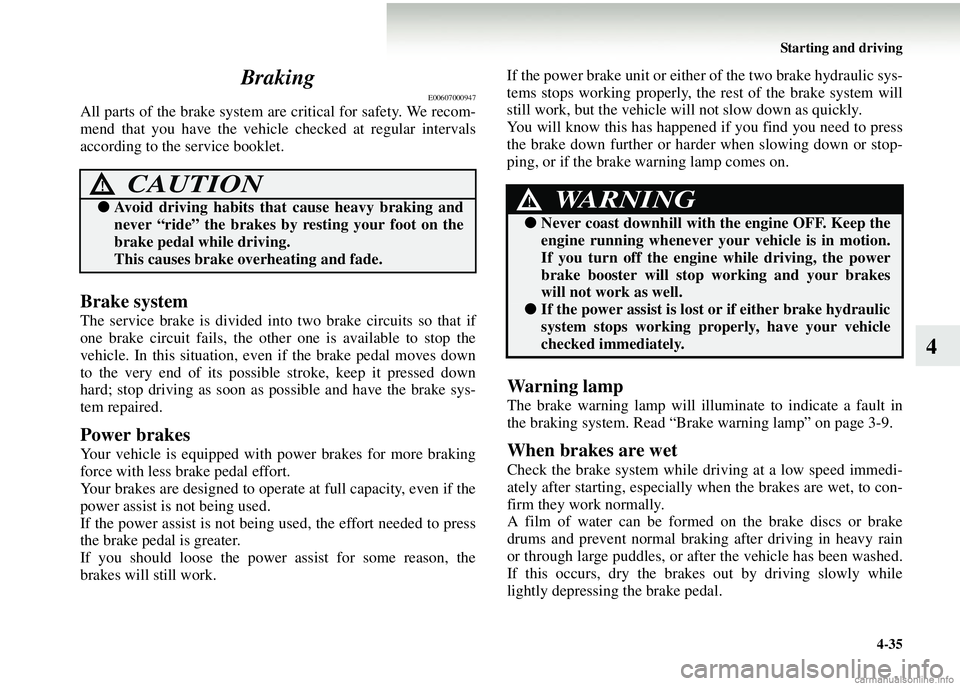
Starting and driving4-35
4
Braking
E00607000947
All parts of the brake system ar
e critical for safety. We recom-
mend that you have the vehicl e checked at regular intervals
according to the service booklet.
Brake system
The service brake is divided into two brake circuits so that if
one brake circuit fails, the othe r one is available to stop the
vehicle. In this situation, ev en if the brake pedal moves down
to the very end of its possible stroke, keep it pressed down
hard; stop driving as soon as possible and have the brake sys-
tem repaired.
Power brakes
Your vehicle is equipped with power brakes for more braking
force with less brake pedal effort.
Your brakes are designed to oper ate at full capacity, even if the
power assist is not being used.
If the power assist is not being used, the effort needed to press
the brake pedal is greater.
If you should loose the power assist for some reason, the
brakes will still work. If the power brake unit or either
of the two brake hydraulic sys-
tems stops working properly, the rest of the brake system will
still work, but the vehicle will not slow down as quickly.
You will know this has happened if you find you need to press
the brake down further or harder when slowing down or stop-
ping, or if the brake warning lamp comes on.
Wa r n i n g l a m p
The brake warning lamp will illuminate to indicate a fault in
the braking system. Read “Brake warning lamp” on page 3-9.
When brakes are wet
Check the brake system while dr iving at a low speed immedi-
ately after starting, especially wh en the brakes are wet, to con-
firm they work normally.
A film of water can be formed on the brake discs or brake
drums and prevent normal braki ng after driving in heavy rain
or through large puddles, or after the vehicle has been washed.
If this occurs, dry the brakes out by driving slowly while
lightly depressing the brake pedal.
CAUTION!
● Avoid driving habits that cause heavy braking and
never “ride” the brakes by resting your foot on the
brake pedal while driving.
This causes brake overheating and fade.WARNING!
● Never coast downhill with the engine OFF. Keep the
engine running whenever your vehicle is in motion.
If you turn off the engine while driving, the power
brake booster will stop working and your brakes
will not work as well.
● If the power assist is lost or if either brake hydraulic
system stops working properly, have your vehicle
checked immediately.
Page 204 of 450
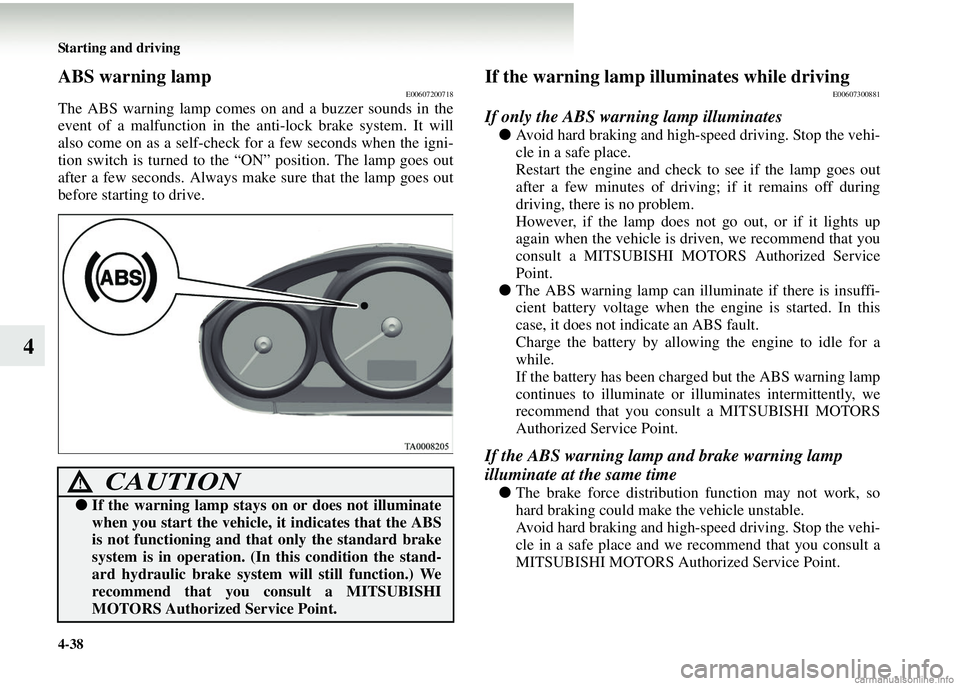
4-38 Starting and driving
4
ABS warning lampE00607200718
The ABS warning lamp comes on and a buzzer sounds in the
event of a malfunction in the anti-lock brake system. It will
also come on as a self-check for a few seconds when the igni-
tion switch is turned to the “ON” position. The lamp goes out
after a few seconds. Always make sure that the lamp goes out
before starting to drive.
If the warning lamp illuminates while drivingE00607300881
If only the ABS warning lamp illuminates
● Avoid hard braking and high-speed driving. Stop the vehi-
cle in a safe place.
Restart the engine and check to see if the lamp goes out
after a few minutes of driving; if it remains off during
driving, there is no problem.
However, if the lamp does not go out, or if it lights up
again when the vehicle is dr iven, we recommend that you
consult a MITSUBISHI MOTORS Authorized Service
Point.
● The ABS warning lamp can illuminate if there is insuffi-
cient battery voltage when the engine is started. In this
case, it does not indicate an ABS fault.
Charge the battery by allowing the engine to idle for a
while.
If the battery has been charged but the ABS warning lamp
continues to illuminate or illuminates intermittently, we
recommend that you cons ult a MITSUBISHI MOTORS
Authorized Service Point.
If the ABS warning lamp and brake warning lamp
illuminate at the same time
● The brake force distribution function may not work, so
hard braking could make the vehicle unstable.
Avoid hard braking and high-speed driving. Stop the vehi-
cle in a safe place and we recommend that you consult a
MITSUBISHI MOTORS Authorized Service Point.CAUTION!
●If the warning lamp stays on or does not illuminate
when you start the vehicle, it indicates that the ABS
is not functioning and that only the standard brake
system is in operation. (I n this condition the stand-
ard hydraulic brake system will still function.) We
recommend that you consult a MITSUBISHI
MOTORS Authorized Service Point.
Page 210 of 450
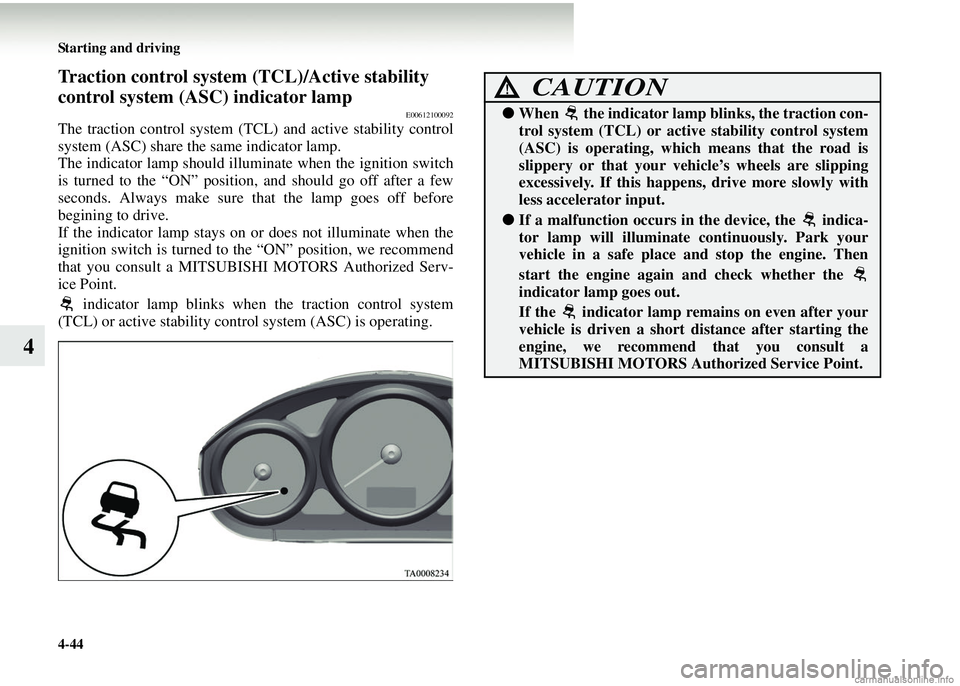
4-44 Starting and driving
4
Traction control system (TCL)/Active stability
control system (ASC) indicator lamp
E00612100092
The traction control system (TCL ) and active stability control
system (ASC) share the same indicator lamp.
The indicator lamp should illuminate when the ignition switch
is turned to the “ON” position, and should go off after a few
seconds. Always make sure that the lamp goes off before
begining to drive.
If the indicator lamp stays on or does not illuminate when the
ignition switch is turned to the “ON” position, we recommend
that you consult a MITSUBISHI MOTORS Authorized Serv-
ice Point.
indicator lamp blinks when the traction control system
(TCL) or active stability contro l system (ASC) is operating.
CAUTION!
●When the indicator lamp blinks, the traction con-
trol system (TCL) or acti ve stability control system
(ASC) is operating, which means that the road is
slippery or that your vehicle’s wheels are slipping
excessively. If this happens, drive more slowly with
less accelerator input.
● If a malfunction occurs in the device, the indica-
tor lamp will illuminate continuously. Park your
vehicle in a safe place and stop the engine. Then
start the engine again and check whether the
indicator lamp goes out.
If the indicator lamp re mains on even after your
vehicle is driven a short distance after starting the
engine, we recommend that you consult a
MITSUBISHI MOTORS Authorized Service Point.
Page 241 of 450
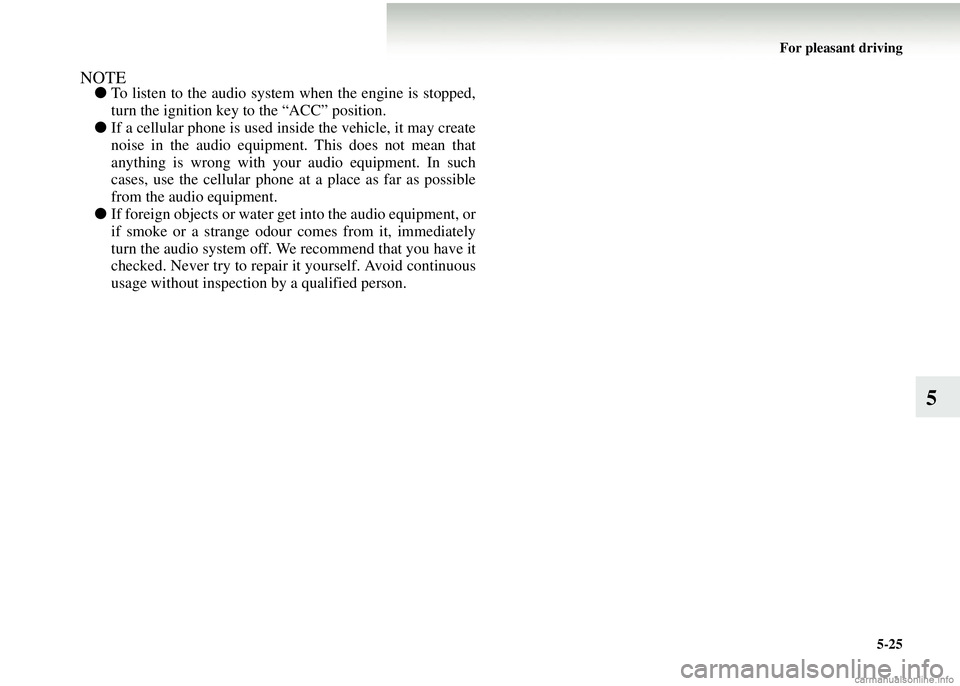
For pleasant driving5-25
5
NOTE●To listen to the audio system when the engine is stopped,
turn the ignition key to the “ACC” position.
● If a cellular phone is used in side the vehicle, it may create
noise in the audio equipment. This does not mean that
anything is wrong with your audio equipment. In such
cases, use the cellular phone at a place as far as possible
from the audio equipment.
● If foreign objects or water get into the audio equipment, or
if smoke or a strange odour comes from it, immediately
turn the audio system off. We recommend that you have it
checked. Never try to repair it yourself. Avoid continuous
usage without inspection by a qualified person.
Page 292 of 450
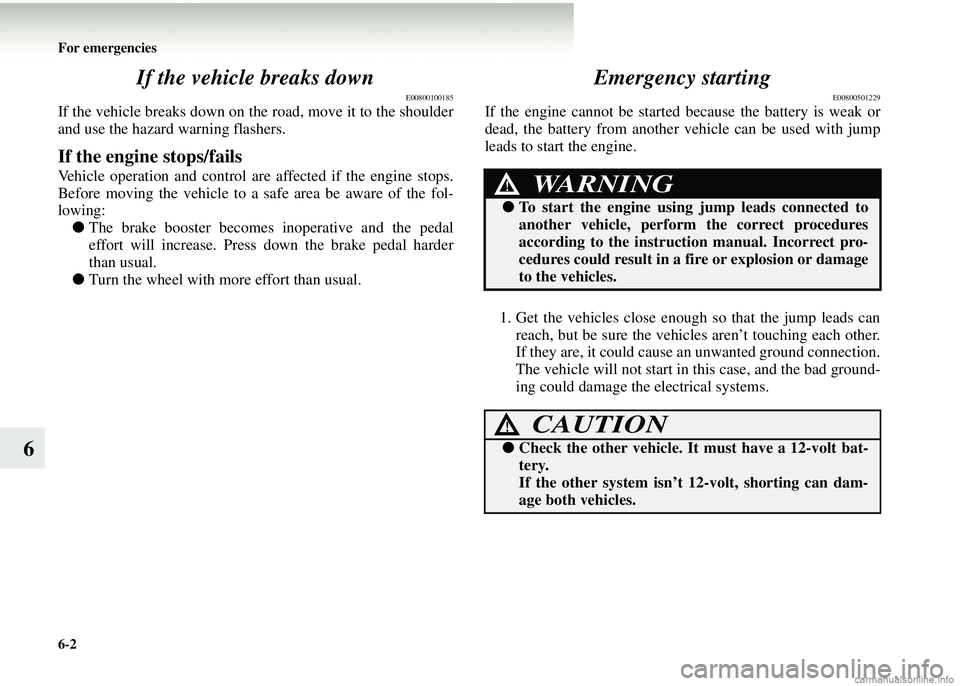
6-2 For emergencies
6If the vehicle breaks down
E00800100185
If the vehicle breaks down on th
e road, move it to the shoulder
and use the hazard warning flashers.
If the engine stops/fails
Vehicle operation and control are affected if the engine stops.
Before moving the vehicle to a safe area be aware of the fol-
lowing: ● The brake booster becomes inoperative and the pedal
effort will increase. Press down the brake pedal harder
than usual.
● Turn the wheel with more effort than usual.
Emergency starting
E00800501229
If the engine cannot be started because the battery is weak or
dead, the battery from another vehicle can be used with jump
leads to start the engine.
1. Get the vehicles close enoug h so that the jump leads can
reach, but be sure the vehicles aren’t touching each other.
If they are, it could cause an unwanted ground connection.
The vehicle will not start in this case, and the bad ground-
ing could damage the electrical systems.
WARNING!
● To start the engine using jump leads connected to
another vehicle, perfor m the correct procedures
according to the instruct ion manual. Incorrect pro-
cedures could result in a fire or explosion or damage
to the vehicles.
CAUTION!
● Check the other vehicle. It must have a 12-volt bat-
tery.
If the other system isn’t 12-volt, shorting can dam-
age both vehicles.
Page 295 of 450
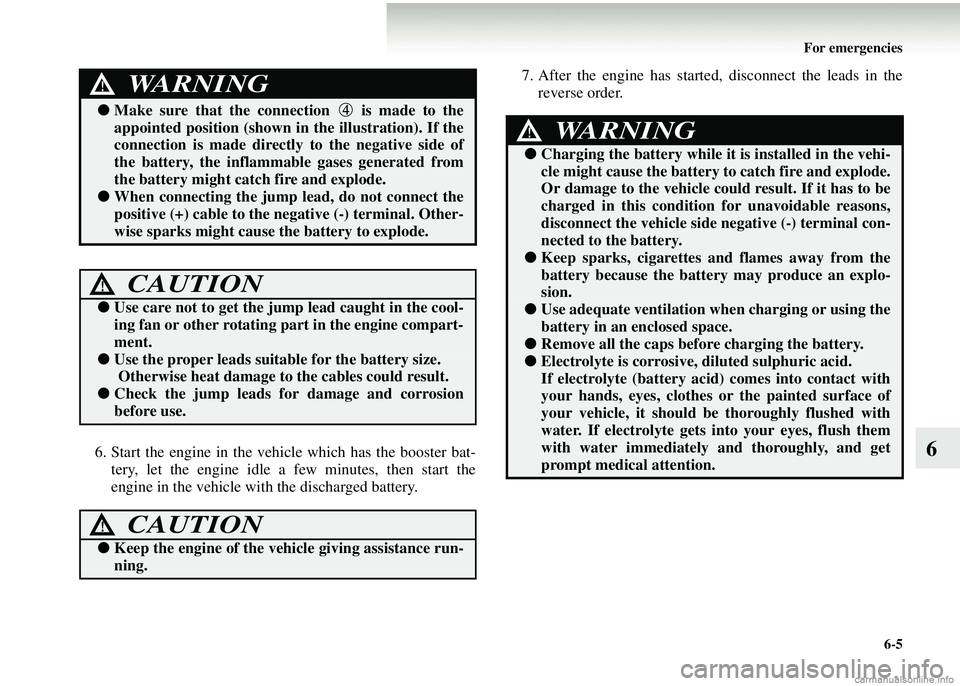
For emergencies6-5
66. Start the engine in the vehicle which has the booster bat-tery, let the engine idle a few minutes, then start the
engine in the vehicle with the discharged battery. 7. After the engine has started, disconnect the leads in the
reverse order.
● Make sure that the conn ection is made to the
appointed position (shown in the illustration). If the
connection is made directly to the negative side of
the battery, the inflammable gases generated from
the battery might catch fire and explode.
● When connecting the jump lead, do not connect the
positive (+) cable to the ne gative (-) terminal. Other-
wise sparks might cause the battery to explode.
CAUTION!
●Use care not to get the jump lead caught in the cool-
ing fan or other rotating part in the engine compart-
ment.
● Use the proper leads suitable for the battery size.
Otherwise heat damage to the cables could result.
●Check the jump leads for damage and corrosion
before use.
CAUTION!
●Keep the engine of the ve hicle giving assistance run-
ning.
WARNING!
WARNING!
● Charging the battery while it is installed in the vehi-
cle might cause the battery to catch fire and explode.
Or damage to the vehicle could result. If it has to be
charged in this condition for unavoidable reasons,
disconnect the vehicle side negative (-) terminal con-
nected to the battery.
● Keep sparks, cigarettes an d flames away from the
battery because the battery may produce an explo-
sion.
● Use adequate ventilation when charging or using the
battery in an enclosed space.
●Remove all the caps before charging the battery.
●Electrolyte is corrosive, diluted sulphuric acid.
If electrolyte (battery ac id) comes into contact with
your hands, eyes, clothes or the painted surface of
your vehicle, it should be thoroughly flushed with
water. If electrolyte gets into your eyes, flush them
with water immediately and thoroughly, and get
prompt medical attention.
Page 296 of 450
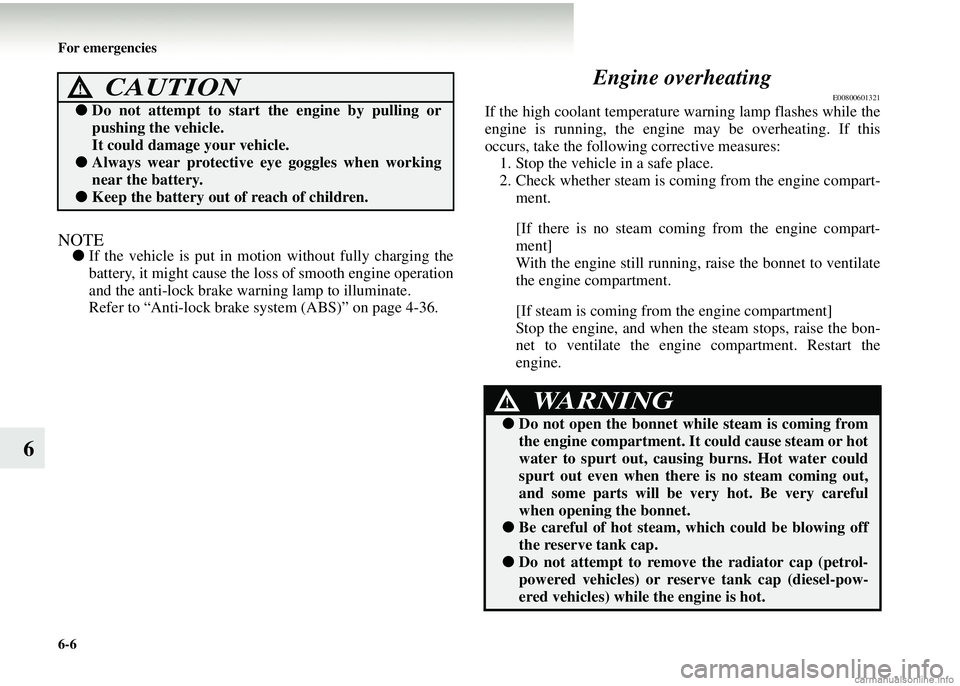
6-6 For emergencies
6
NOTE●If the vehicle is put in motion without fully charging the
battery, it might cause the loss of smooth engine operation
and the anti-lock brake warning lamp to illuminate.
Refer to “Anti-lock brake system (ABS)” on page 4-36.
Engine overheating
E00800601321
If the high coolant temperature warning lamp flashes while the
engine is running, the engine may be overheating. If this
occurs, take the follow ing corrective measures:
1. Stop the vehicle in a safe place.
2. Check whether steam is comin g from the engine compart-
ment.
[If there is no steam comi ng from the engine compart-
ment]
With the engine still running, raise the bonnet to ventilate
the engine compartment.
[If steam is coming from the engine compartment]
Stop the engine, and when the steam stops, raise the bon-
net to ventilate the engine compartment. Restart the
engine.
CAUTION!
● Do not attempt to start the engine by pulling or
pushing the vehicle.
It could damage your vehicle.
●Always wear protective eye goggles when working
near the battery.
●Keep the battery out of reach of children.
WARNING!
●Do not open the bonnet wh ile steam is coming from
the engine compartment. It could cause steam or hot
water to spurt out, causin g burns. Hot water could
spurt out even when there is no steam coming out,
and some parts will be very hot. Be very careful
when opening the bonnet.
●Be careful of hot steam, which could be blowing off
the reserve tank cap.
●Do not attempt to remove the radiator cap (petrol-
powered vehicles) or res erve tank cap (diesel-pow-
ered vehicles) while the engine is hot.
Page 297 of 450
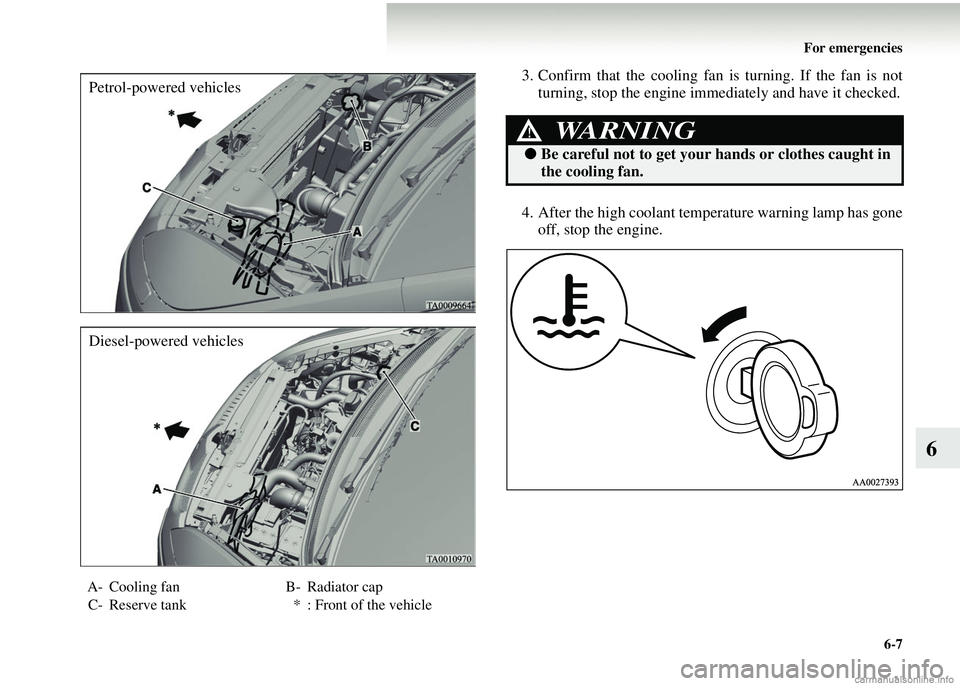
For emergencies6-7
6
3. Confirm that the cooling fan is turning. If the fan is notturning, stop the engine im mediately and have it checked.
4. After the high coolant temp erature warning lamp has gone
off, stop the engine.
A- Cooling fan B- Radiator cap
C- Reserve tank * : Front of the vehicle
Petrol-powered vehicles
Diesel-powered vehicles
WARNING!
●Be careful not to get your hands or clothes caught in
the cooling fan.
Page 299 of 450
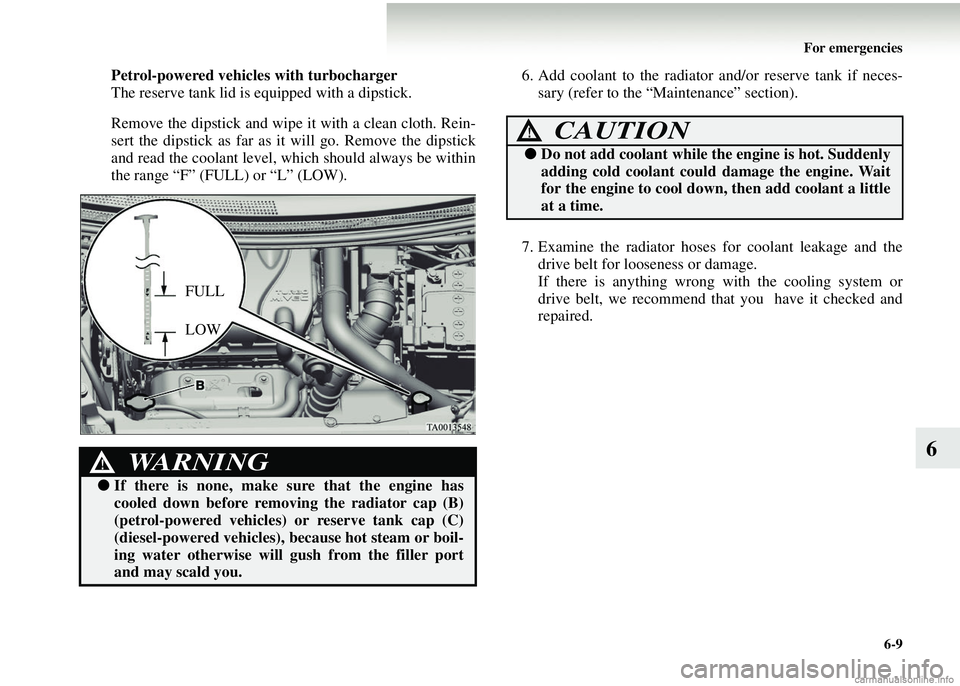
For emergencies6-9
6
Petrol-powered vehicles with turbocharger
The reserve tank lid is equipped with a dipstick.
Remove the dipstick and wipe it with a clean cloth. Rein-
sert the dipstick as far as it will go. Remove the dipstick
and read the coolant level, which should always be within
the range “F” (FULL) or “L” (LOW). 6. Add coolant to the radiator
and/or reserve tank if neces-
sary (refer to the “Maintenance” section).
7. Examine the radiator hoses for coolant leakage and the drive belt for looseness or damage.
If there is anything wrong with the cooling system or
drive belt, we recommend that you have it checked and
repaired.
WARNING!
● If there is none, make sure that the engine has
cooled down before removi ng the radiator cap (B)
(petrol-powered vehicles) or reserve tank cap (C)
(diesel-powered vehicles), because hot steam or boil-
ing water otherwise will gush from the filler port
and may scald you.
FULL
LOW
CAUTION!
● Do not add coolant while the engine is hot. Suddenly
adding cold coolant coul d damage the engine. Wait
for the engine to cool down, then add coolant a little
at a time.
Page 327 of 450
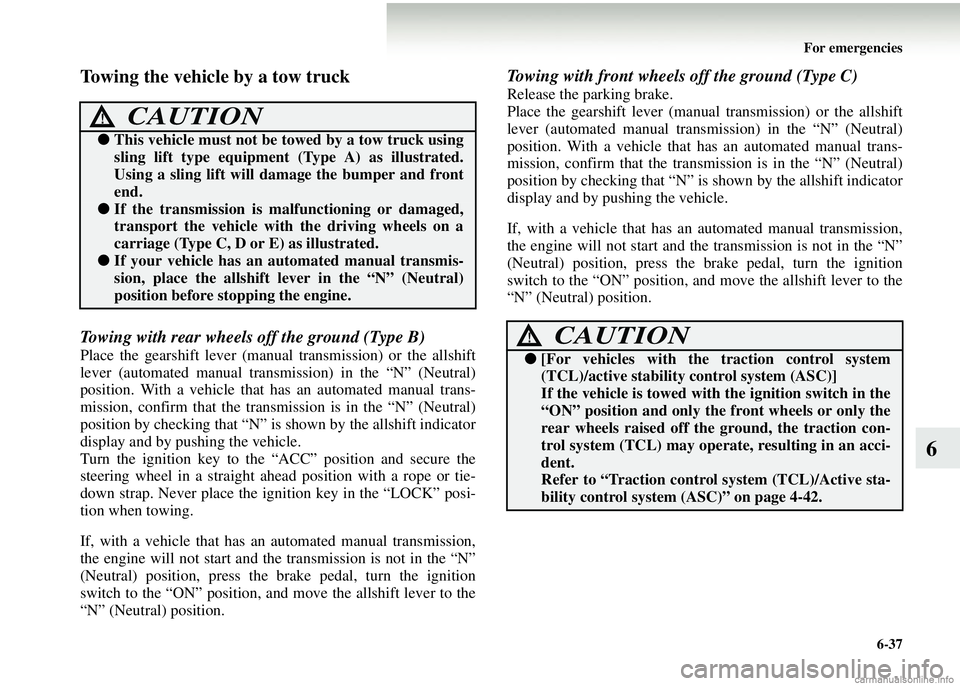
For emergencies6-37
6
Towing the vehicle by a tow truck
Towing with rear wheels off the ground (Type B)
Place the gearshift lever (manual transmission) or the allshift
lever (automated manual transm ission) in the “N” (Neutral)
position. With a vehicle that has an automated manual trans-
mission, confirm that the transm ission is in the “N” (Neutral)
position by checking that “N” is shown by the allshift indicator
display and by pushing the vehicle.
Turn the ignition key to the “ACC” position and secure the
steering wheel in a straight ah ead position with a rope or tie-
down strap. Never place the igni tion key in the “LOCK” posi-
tion when towing.
If, with a vehicle that has an automated manual transmission,
the engine will not start and the transmission is not in the “N”
(Neutral) position, press the brake pedal, turn the ignition
switch to the “ON” position, and move the allshift lever to the
“N” (Neutral) position.
Towing with front wheels off the ground (Type C)
Release the parking brake.
Place the gearshift lever (manual transmission) or the allshift
lever (automated manual transm ission) in the “N” (Neutral)
position. With a vehicle that has an automated manual trans-
mission, confirm that the transmi ssion is in the “N” (Neutral)
position by checking th at “N” is shown by the allshift indicator
display and by pushing the vehicle.
If, with a vehicle that has an automated manual transmission,
the engine will not start and th e transmission is not in the “N”
(Neutral) position, press the brake pedal, turn the ignition
switch to the “ON” position, and move the allshift lever to the
“N” (Neutral) position.
CAUTION!
● This vehicle must not be towed by a tow truck using
sling lift type equipment (Type A) as illustrated.
Using a sling lift will da mage the bumper and front
end.
● If the transmission is malfunctioning or damaged,
transport the vehicle with the driving wheels on a
carriage (Type C, D or E) as illustrated.
●If your vehicle has an automated manual transmis-
sion, place the a llshift lever in the “N” (Neutral)
position before stopping the engine.
CAUTION!
● [For vehicles with the traction control system
(TCL)/active stability control system (ASC)]
If the vehicle is towed with the ignition switch in the
“ON” position and only th e front wheels or only the
rear wheels raised off the ground, the traction con-
trol system (TCL) may operate, resulting in an acci-
dent.
Refer to “Traction control system (TCL)/Active sta-
bility control system (ASC)” on page 4-42.